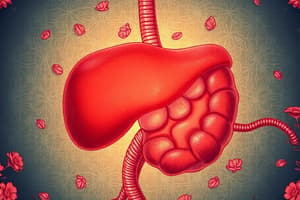Podcast
Questions and Answers
Which of the following is true about cholesterol synthesis?
Which of the following is true about cholesterol synthesis?
- It is regulated by the expression of HMG-CoA reductase. (correct)
- It occurs in the cytoplasm.
- It is an energetically inexpensive process.
- It is derived from fatty acids.
What is the function of cholesterol in the body?
What is the function of cholesterol in the body?
- It is an essential component of plasma and intracellular membranes.
- It regulates the fluidity of lipid bilayers.
- It is an abundant component of the myelin sheath.
- All of the above. (correct)
Which of the following is true about cholesterol synthesis intermediates?
Which of the following is true about cholesterol synthesis intermediates?
- They are produced in the nucleus.
- They are regulated by statins.
- They are isoprenoid precursors. (correct)
- They are derived from fatty acids.
What is the rate limiting step in cholesterol synthesis?
What is the rate limiting step in cholesterol synthesis?
Which of the following is a pharmacological target of cholesterol synthesis?
Which of the following is a pharmacological target of cholesterol synthesis?
What is the major site of cholesterol synthesis in the body?
What is the major site of cholesterol synthesis in the body?
Which of the following is a genetic deficiency in cholesterol synthesis?
Which of the following is a genetic deficiency in cholesterol synthesis?
What is the effect of plasma cholesterol levels on the intracellular synthesis of cholesterol?
What is the effect of plasma cholesterol levels on the intracellular synthesis of cholesterol?
How does cholesterol regulate the lateral mobility of macromolecules and proteins?
How does cholesterol regulate the lateral mobility of macromolecules and proteins?
What is the function of cholesterol esters?
What is the function of cholesterol esters?
Which enzyme is the rate limiting step in cholesterol synthesis?
Which enzyme is the rate limiting step in cholesterol synthesis?
What provides the reducing equivalents required for cholesterol synthesis?
What provides the reducing equivalents required for cholesterol synthesis?
Where is HMG-CoA reductase located?
Where is HMG-CoA reductase located?
Which stage of cholesterol synthesis involves the conversion of squalene to cholesterol?
Which stage of cholesterol synthesis involves the conversion of squalene to cholesterol?
What is the most common disorder of sterol synthesis?
What is the most common disorder of sterol synthesis?
Which enzyme deficiency is associated with Smith Lemli Opitz Syndrome?
Which enzyme deficiency is associated with Smith Lemli Opitz Syndrome?
What is the main fate of cholesterol in the body?
What is the main fate of cholesterol in the body?
Which enzyme transfers a fatty acid to the hydroxyl group of cholesterol?
Which enzyme transfers a fatty acid to the hydroxyl group of cholesterol?
What is the most frequently reported clinical finding in Smith Lemli Opitz Syndrome?
What is the most frequently reported clinical finding in Smith Lemli Opitz Syndrome?
What are the clinical presentations of Vitamin D deficiency?
What are the clinical presentations of Vitamin D deficiency?
Flashcards are hidden until you start studying
Study Notes
Cholesterol Synthesis
- Cholesterol synthesis is a multi-step process that occurs in the liver and other tissues.
- The function of cholesterol in the body is to maintain the structure and fluidity of cell membranes, and to serve as a precursor to bile acids, steroid hormones, and vitamin D.
Cholesterol Synthesis Intermediates
- Intermediates in the cholesterol synthesis pathway include HMG-CoA, mevalonate, and squalene.
- These intermediates are used to synthesize cholesterol and other important molecules.
Rate Limiting Step
- The rate limiting step in cholesterol synthesis is the conversion of HMG-CoA to mevalonate, catalyzed by HMG-CoA reductase.
- HMG-CoA reductase is a key enzyme in the cholesterol synthesis pathway and is inhibited by statins, a class of cholesterol-lowering drugs.
Pharmacological Targets
- HMG-CoA reductase is a pharmacological target of cholesterol synthesis, and is inhibited by statins to reduce cholesterol levels.
- Statins are used to treat high cholesterol and reduce the risk of cardiovascular disease.
Site of Cholesterol Synthesis
- The major site of cholesterol synthesis in the body is the liver, although other tissues such as the adrenal glands and reproductive organs also synthesize cholesterol.
Genetic Deficiencies
- Smith-Lemli-Opitz Syndrome is a genetic deficiency in cholesterol synthesis, caused by a defect in the enzyme 7-dehydrocholesterol reductase.
- This deficiency leads to abnormal cholesterol levels and a range of developmental and physical abnormalities.
Regulation of Cholesterol Synthesis
- Plasma cholesterol levels have a negative feedback effect on the intracellular synthesis of cholesterol, reducing the activity of HMG-CoA reductase.
- This helps to regulate cholesterol levels and prevent excessive synthesis.
Cholesterol Function
- Cholesterol regulates the lateral mobility of macromolecules and proteins in cell membranes, helping to maintain membrane structure and function.
- Cholesterol esters are stored in the liver and other tissues, and can be used to synthesize bile acids, steroid hormones, and vitamin D.
Enzymes and Reducing Equivalents
- HMG-CoA reductase is the rate limiting enzyme in cholesterol synthesis, and is located in the endoplasmic reticulum.
- NADPH provides the reducing equivalents required for cholesterol synthesis.
Stage of Cholesterol Synthesis
- The stage of cholesterol synthesis involving the conversion of squalene to cholesterol is catalyzed by the enzyme lanosterol synthase.
Disorders of Sterol Synthesis
- The most common disorder of sterol synthesis is Smith-Lemli-Opitz Syndrome, caused by a defect in the enzyme 7-dehydrocholesterol reductase.
- This deficiency leads to abnormal cholesterol levels and a range of developmental and physical abnormalities.
Vitamin D Deficiency
- Clinical presentations of vitamin D deficiency include rickets, osteomalacia, and increased risk of osteoporosis.
- Vitamin D deficiency can also lead to increased risk of cardiovascular disease and impaired immune function.
Studying That Suits You
Use AI to generate personalized quizzes and flashcards to suit your learning preferences.




